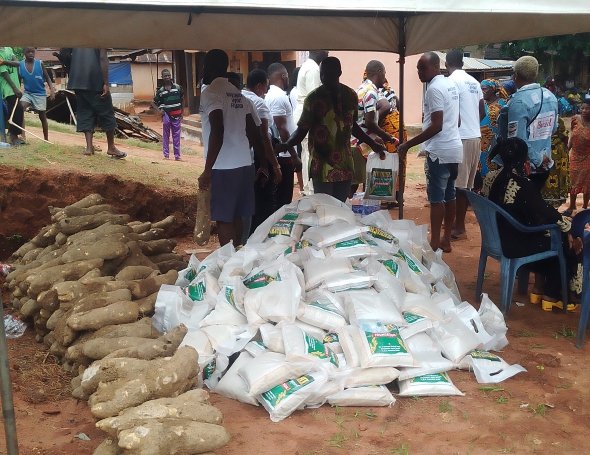Emergency relief efforts are essential in addressing the urgent needs that arise during crises, including natural disasters, humanitarian emergencies, and pandemics. Such events often lead to significant disruption of daily life, leaving affected populations vulnerable and in dire need of support. For instance, natural disasters such as hurricanes, earthquakes, and floods can result in extensive damage to infrastructure, displacement of communities, and overwhelming challenges in accessing basic necessities like food, clean water, and shelter.
Humanitarian crises, often triggered by armed conflicts or systemic oppression, further exacerbate situations where individuals require immediate intervention. Millions of people may find themselves in refugee camps with limited resources, facing food scarcity and inadequate healthcare. These conditions underscore the importance of organized emergency relief efforts capable of delivering essential services rapidly and efficiently, thereby alleviating human suffering.
Moreover, during pandemics, the population may experience heightened health risks, compounded by economic strain. Access to healthcare services is crucial in mitigating the impacts of such outbreaks, and emergency response initiatives play a pivotal role in ensuring that medical supplies, personnel, and information reach those in need. The immediate impacts of these crises highlight not only the physical loss of shelter and health but also the psychological toll on individuals who have lost loved ones or witnessed traumatic events.
In this context, swift and organized relief efforts become critical. They not only address the immediate needs of communities but also lay the groundwork for recovery and rebuilding. By providing access to food, water, and medical care, organizations can significantly contribute to saving lives and fostering resilience among affected populations. The necessity for these emergency relief efforts cannot be overstated, serving as a lifeline that aids communities in their most challenging times.
Key Components of Effective Emergency Response
Effective emergency response is critical during times of crisis, necessitating a coordinated effort among various stakeholders, including government agencies, non-governmental organizations (NGOs), and local communities. This collaboration is essential for addressing the immediate needs of affected populations and ensuring that relief efforts reach those in need as swiftly as possible. One of the crucial components of an effective emergency response is the seamless coordination among these different entities. Such collaboration facilitates the sharing of resources and information, allowing for a more unified approach in managing the crisis.
Resource mobilization is another vital aspect of emergency response. This involves the gathering and deployment of essential supplies, personnel, and financial support. Effective resource mobilization ensures that assistance reaches the affected areas quickly and sustainably, helping the communities to recover from disasters. Agencies often implement pre-established plans to swiftly identify and allocate the necessary resources, reducing delays that can exacerbate the situation on the ground.
Logistics management further enhances the efficiency of emergency response efforts. This entails the planning and execution of the transportation, distribution, and storage of supplies. Complex logistical challenges are common during crises, especially in remote or hard-to-reach areas. Therefore, organizations must develop robust logistical frameworks to navigate these challenges and ensure timely delivery of aid.
Rapid assessment also plays a pivotal role in understanding the needs of the affected population. This involves quickly gathering data to identify urgent requirements, enabling responsive action that is tailored to the unique circumstances of the disaster. Coupled with effective communication strategies, the assessment process can significantly amplify the impact of relief efforts, fostering transparency and trust among stakeholders and the communities served.
Historical examples of successful emergency response coordination, such as the international aid efforts following the 2010 Haiti earthquake, illustrate how these components work in harmony to save lives and promote recovery. By prioritizing these key elements, organizations can enhance their emergency response capabilities and provide critical support during crises.
Challenges Faced in Emergency Relief Efforts
Emergency relief efforts are vital in alleviating the suffering of communities affected by crises, yet they often encounter a multitude of challenges that can hinder their efficacy. One of the most significant obstacles is resource shortages, which can stem from both the influx of individuals needing assistance and the inadequate supply chains that often accompany disasters. For instance, natural disasters may render transportation routes unusable, making it difficult to provide food, water, and medical supplies to those in dire need. Volunteers and relief workers frequently report that they must make difficult decisions regarding resource allocation when faced with overwhelming demand.
Additionally, political instability can severely complicate emergency relief operations. In regions where governance is weak or authorities are uncooperative, relief efforts can be delayed or obstructed altogether. This phenomenon has been observed in various humanitarian crises, where the lack of government support and coordination results in chaotic conditions that endanger both relief workers and those they aim to assist. Personal accounts from volunteers illustrate the frustrations felt in navigating these complex environments, often highlighting moments of uncertainty and the urgent need for clear communication with local authorities.
Logistical hurdles are another significant challenge that emergency relief efforts must overcome. The unpredictable nature of disasters can disrupt established plans, leading to inefficiencies. For example, volunteers may encounter difficulties in coordinating with multiple organizations, each with differing protocols and objectives. Furthermore, the emotional toll on relief workers, who frequently work long hours under intense pressure, adds another layer to the challenges faced. Their stories of resilience highlight the dedication required to continue efforts despite the obstacles, demonstrating a commitment to serving those in need even when circumstances are far from ideal.
Impact of Emergency Relief: Case Studies and Success Stories
Emergency relief efforts have consistently played a pivotal role in alleviating human suffering during crises. By examining various case studies and success stories, we can gain valuable insights into the effectiveness of these initiatives and their lasting impact on communities. One notable example is the response to the 2010 Haiti earthquake. In the wake of this catastrophic event, numerous humanitarian organizations mobilized quickly to provide essential support, including food, water, and medical care. As a result of these collective efforts, thousands of lives were saved and the foundation for long-term recovery was laid.
Another inspiring case can be found in the aftermath of Typhoon Haiyan in the Philippines, which struck in 2013. Various NGOs, local governments, and international agencies worked diligently to deliver emergency assistance amidst a challenging environment. Relief efforts included immediate distribution of food and shelter, followed by initiatives to restore livelihoods and infrastructure. Through this collaboration, affected communities witnessed not only a rapid response but also a sustainable recovery process, empowering them to rebuild their lives and futures.
In regions impacted by chronic food insecurity, emergency relief has also shifted towards enhancing resilience and providing sustainable solutions. For instance, a program implemented in East Africa focused on integrating cash-based assistance with agricultural support. This approach enabled families to meet their immediate needs while also investing in long-term agricultural practices, significantly contributing to community resilience against future crises.
The analysis of these case studies underscores the importance of well-coordinated emergency response initiatives. They not only address immediate needs but also foster community resilience, demonstrating that effective emergency relief can create a meaningful and lasting change. These success stories exemplify how impactful relief efforts can inspire hope and lead to renewed commitment in similar future endeavor. Demonstrating that effective emergency relief can create a meaningful and lasting change. These success stories exemplify how impactful relief efforts can inspire hope and lead to renewed commitment in similar future endeavors.













**mindvault**
mindvault is a premium cognitive support formula created for adults 45+. It’s thoughtfully designed to help maintain clear thinking
**glpro**
glpro is a natural dietary supplement designed to promote balanced blood sugar levels and curb sugar cravings.
**sugarmute**
sugarmute is a science-guided nutritional supplement created to help maintain balanced blood sugar while supporting steady energy and mental clarity.
**vittaburn**
vittaburn is a liquid dietary supplement formulated to support healthy weight reduction by increasing metabolic rate, reducing hunger, and promoting fat loss.
**synaptigen**
synaptigen is a next-generation brain support supplement that blends natural nootropics, adaptogens
**glucore**
glucore is a nutritional supplement that is given to patients daily to assist in maintaining healthy blood sugar and metabolic rates.
**prodentim**
prodentim an advanced probiotic formulation designed to support exceptional oral hygiene while fortifying teeth and gums.
**nitric boost**
nitric boost is a dietary formula crafted to enhance vitality and promote overall well-being.
**sleep lean**
sleeplean is a US-trusted, naturally focused nighttime support formula that helps your body burn fat while you rest.
**wildgut**
wildgutis a precision-crafted nutritional blend designed to nurture your dog’s digestive tract.
**mitolyn**
mitolyn a nature-inspired supplement crafted to elevate metabolic activity and support sustainable weight management.
**yu sleep**
yusleep is a gentle, nano-enhanced nightly blend designed to help you drift off quickly, stay asleep longer, and wake feeling clear.
**zencortex**
zencortex contains only the natural ingredients that are effective in supporting incredible hearing naturally.
**breathe**
breathe is a plant-powered tincture crafted to promote lung performance and enhance your breathing quality.
**prostadine**
prostadine is a next-generation prostate support formula designed to help maintain, restore, and enhance optimal male prostate performance.
**pinealxt**
pinealxt is a revolutionary supplement that promotes proper pineal gland function and energy levels to support healthy body function.
**energeia**
energeia is the first and only recipe that targets the root cause of stubborn belly fat and Deadly visceral fat.
**prostabliss**
prostabliss is a carefully developed dietary formula aimed at nurturing prostate vitality and improving urinary comfort.
**boostaro**
boostaro is a specially crafted dietary supplement for men who want to elevate their overall health and vitality.
**potentstream**
potentstream is engineered to promote prostate well-being by counteracting the residue that can build up from hard-water minerals within the urinary tract.
**hepato burn**
hepato burn is a premium nutritional formula designed to enhance liver function, boost metabolism, and support natural fat breakdown.
**hepatoburn**
hepatoburn is a potent, plant-based formula created to promote optimal liver performance and naturally stimulate fat-burning mechanisms.
**flowforce max**
flowforce max delivers a forward-thinking, plant-focused way to support prostate health—while also helping maintain everyday energy, libido, and overall vitality.
**neuro genica**
neuro genica is a dietary supplement formulated to support nerve health and ease discomfort associated with neuropathy.
**cellufend**
cellufend is a natural supplement developed to support balanced blood sugar levels through a blend of botanical extracts and essential nutrients.
**prodentim**
prodentim is a forward-thinking oral wellness blend crafted to nurture and maintain a balanced mouth microbiome.
**revitag**
revitag is a daily skin-support formula created to promote a healthy complexion and visibly diminish the appearance of skin tags.
**hepato burn**
hepato burn is a potent, plant-based formula created to promote optimal liver performance and naturally stimulate fat-burning mechanisms.
Your point of view caught my eye and was very interesting. Thanks. I have a question for you.
Your point of view caught my eye and was very interesting. Thanks. I have a question for you.
Thank you for your sharing. I am worried that I lack creative ideas. It is your article that makes me full of hope. Thank you. But, I have a question, can you help me?
Kho game khổng lồ hấp dẫn thành viên tham gia tại link 188v chính thức không thể không kể đến dòng nổ hũ với phần thưởng lên tới hàng tỷ đồng. Tại đây có hàng trăm sản phẩm khác nhau với giao diện, cách chơi khác nhau, đưa tới trải nghiệm thú vị, không bao giờ nhàm chán cho thành viên tham gia. TONY12-10A
Thanks for sharing. I read many of your blog posts, cool, your blog is very good. https://accounts.binance.info/es/register?ref=RQUR4BEO
Thị trường nhà cái uy tín đổi thưởng ngày càng bùng nổ với vô số lựa chọn, nhưng liệu đâu là nền tảng thực sự đáng tin cậy? Nhiều người chơi đã phải học bài học đắt giá khi tham gia các nhà cái thiếu minh bạch: tiền thắng không thể rút, tài khoản bị khóa vô cớ, hay tỷ lệ trả thưởng không công bằng. Hãy cùng khám phá 888SLOT – một lựa chọn đang được đánh giá cao bởi cộng đồng người chơi nhờ tính minh bạch, bảo mật và đa dạng trò chơi. TONY12-19
888slot 888 slot còn cung cấp nhiều chương trình khuyến mãi và quảng cáo lớn khác, thường xuyên được cập nhật và điều chỉnh, mang đến điều gì đó mới mẻ và thú vị cho người tham gia mỗi lần họ truy cập. TONY12-19
Tried out pkzzgame, controls are easy enough to pick up. If you are looking for something casual to play this should do nicely. Get it here: pkzzgame
Your point of view caught my eye and was very interesting. Thanks. I have a question for you.
Can you be more specific about the content of your article? After reading it, I still have some doubts. Hope you can help me.
I don’t think the title of your article matches the content lol. Just kidding, mainly because I had some doubts after reading the article. https://accounts.binance.info/register-person?ref=IHJUI7TF
Thank you for your sharing. I am worried that I lack creative ideas. It is your article that makes me full of hope. Thank you. But, I have a question, can you help me? https://accounts.binance.com/register-person?ref=IHJUI7TF